Recently Digitised Material – July 2024

Read on to discover some of the newly digitised Tasmanian Archives and State Library of Tasmania Heritage collections from His Majesty’s Theatre Hobart, Beaconsfield Mines, land grant application registrations and more! To discover more material from our collections, search our catalogue and Tasmanian Names Index or visit us on Flickr, YouTube and Instagram.
His Majesty’s Theatre, Hobart (Tasmanian Archives: NS201 and NS6804)
The 1910s facade of 168 Liverpool Street spent many years covered over with cladding, but was re-revealed in March 2024. Number 168 had a former life as a His Majesty’s Theatre, staging productions in the early 20th century before becoming a cinema and then clothing store. You can see its former glory in the original drawings by Clark & Crisp architects (Tasmanian Archives:
NS6804/1/12) and glass plate negatives collected by George Billing (Tasmanian Archives: NS201).
Plans from NS6804 are part of the Designhaus Architects collection, which include plans and elevations from His Majesty’s Theatre, Moonah Theatre and St David’s Cathedral. Designhaus is an architectural practice with a long history. The business was established in 1855 by renowned architect, Henry Hunter. Since then, the firm has comprised various partnerships and contributed significantly to the Tasmania built landscape.
The NS201 series of glass plate negatives was collected by George Billing (1911-2000) and includes many portraits and various scenes from southern Tasmania. George Billing was born in Sheffield in 1911. He retired from the Police Department as an Inspector in the Uniform Branch and made a life member of the Order of Australia in 1989. He founded the Post Office Museum and he had an interest in photography and was president of the Australian Photographic Society in 1970. He appeared on several Television shows including “Childrens Time.”
![Photograph - His Majesty's Theatre, Hobart (built 1910) - front [March 1928, movie 'What Price Glory' screening] [glass plate]](/wp-content/uploads/2024/07/NS201-1-505-1024x756.jpg)
His Majesty’s Theatre, Hobart (built 1910) – front [March 1928, movie ‘What Price Glory’ screening] [glass plate] (Tasmanian Archives: NS201/1/505)
![Photograph - Man in street dressed to advertise movie 'Resurrection' Nov 1931, Hobart [glass plate negative] [His Majestys Theatre, Liverpool Street]](/wp-content/uploads/2024/07/NS201-1-503-3-1024x761.jpg)
![Photograph - Man with 'baby' in a pram to advertise the movie 'The Bachelor's baby' aug 1927 [glass plate negative] [His Majesty's Theatre, Liverpool Street]](/wp-content/uploads/2024/07/NS201-1-504-3-1024x760.jpg)
![Photograph - General Hospital Hobart, entrance Liverpool Street [advertising sign for movie "Oh What a Nurse' - Aug 1927] [glass plate]](/wp-content/uploads/2024/07/NS201-1-497-1024x757.jpg)
From left: Man in street dressed to advertise movie ‘Resurrection’ Nov 1931, Hobart [glass plate negative] [His Majesty’s Theatre, Liverpool Street] (Tasmanian Archives: NS201/1/503), Man with ‘baby’ in a pram to advertise the movie ‘The Bachelor’s baby’ Aug 1927 [glass plate negative] [His Majestys Theatre, Liverpool Street] (Tasmanian Archives: NS201/1/504), General Hospital Hobart, entrance Liverpool Street [advertising sign for movie “Oh What a Nurse’ – Aug 1927] [glass plate] (Tasmanian Archives: NS201/1/497.

Plan – Blue Print – New Theatre, Liverpool St, Hobart for His Majesty’s Theatre Co. Ltd – north, south and east elevations / Clark and Crips Architects (Tasmanian Archives: NS6804-1-4)
![Plan - watercolour on paper - Proposed New Theatre, Liverpool Street, Hobart - front elevation / Clark and Crips Architects [His Majesty's Theatre, Liverpool Street]](/wp-content/uploads/2024/07/NS6804-1-12-782x1024.jpg)
Plan – watercolour on paper – Proposed New Theatre, Liverpool Street, Hobart – front elevation / Clark and Crips Architects [His Majesty’s Theatre, Liverpool Street] (Tasmanian Archives: NS6804-1-12)
Frederick Smithies Lantern Slide Collection (Tasmanian Archives, NS573/6/1/1-388)
This series comprises lantern slides taken or collected by Frederick Smithies and Gustav Weindorfer with images of Tasmania, mainly of landscapes, walking expeditions, and remote huts. Most relate to Cradle Mountain. Attribution to Smithies or Weindorfer is not always clear.
Frederick Smithies (1885 – 1979) was a conservationist, bushwalker, wilderness explorer and photographer born at Ulverstone on the 16 August 1885, but lived most of his life in Launceston where he was the manager of the Launceston branch of the Atlas Assurance Company from April 1912 until his retirement fifty years later in April 1962. In middle age he became an enthusiastic bushwalker, exploring the natural environment of his own state. He travelled the rugged West coast on his ‘Indian’ motorcycle and later his ‘A’ model Ford purchased in April 1929; climbed Frenchman’s Cap with his friend Cliff Bradshaw; backpacked into the Florentine and Rasselas Valley area around Adamsfield and walked from Queenstown to Cradle Mountain. He became friends with Gustav Weindorfer (1874 – 1932) of Waldheim Chalet and became very involved with the Cradle Mountain area as a consequence of this relationship. He was a talented wilderness photographer and was a member of an international stereoscopic photographic club. He took 16mm movie film and often carried equipment weighing 70lb (32k) into remote and difficult areas. He used his wilderness images to promote Tasmania’s natural beauty to tourists and to raise awareness about visiting and protecting these areas by giving lectures around Tasmania and in other states on behalf of the Tasmanian government.
![Photograph - Two men standing to side of hut (one looking down at map) [Lantern Slide - yellow tinged]](/wp-content/uploads/2024/07/NS573-6-1-207-3-1024x1024.jpg)
![Photograph - Bridge Hotel at Ouse, with man and chickens in yard (hand coloured) [Lantern Slide] [Box 4]](/wp-content/uploads/2024/07/NS573-6-1-279-1-1024x1021.jpg)
![Photograph - Snowscape with plants [Lantern Slide - yellow tinged]](/wp-content/uploads/2024/07/NS573-6-1-296-2-1024x1021.jpg)
![Photograph - Picking Apples, Huon, Tasmania (Hand coloured) [Lantern Slide] [Box 5 (small box 2)]](/wp-content/uploads/2024/07/NS573-6-1-349-2-1024x1010.jpg)
![Photograph - 'A Crag on Little Horn, Cradle Mt.' (woman standing, man seated on high rocks) (circle frame) [Lantern Slide - blue tone ] [Box 4]](/wp-content/uploads/2024/07/NS573-6-1-334-2-1024x1021.jpg)
![Photograph - On Thetis showing Du Cane Ranbfe [Female bushwalker standing on clifftop, watching sky and mountain tops in distance] [Lantern Slide] [Box 2]](/wp-content/uploads/2024/07/NS573-6-1-148-2-1024x1016.jpg)
![Photograph - Group of eighteen people posing for photograph outside wooden hut [Legges Tor ?] / Frederick Smithies [Lantern Slide] [Box 1]](/wp-content/uploads/2024/07/NS573-6-1-56-1-1020x1024.jpg)
![Photograph - 'Derwent at New Norfolk, TAS' (steamboat on river in background) (hand coloured) [Lantern Slide] [Box 5 (small box 2)]](/wp-content/uploads/2024/07/NS573-6-1-348-1-1024x1010.jpg)
![Photograph - Waldheim in snow / Frederick Smithies [Lantern Slide] [Box 1]](/wp-content/uploads/2024/07/NS573-6-1-28-1-1024x1024.jpg)
From left: Two men standing to side of hut (one looking down at map) (Tasmanian Archives: NS573-6-1-207), Bridge Hotel at Ouse, with man and chickens in yard (hand coloured), (Tasmanian Archives: NS573-6-1-279, Snowscape with plants (Tasmanian Archives: NS573-6-1-296), Picking Apples, Huon, Tasmania (Hand coloured) (Tasmanian Archives: NS573-6-1-349), ‘A Crag on Little Horn, Cradle Mt.’ (Tasmanian Archives: NS573-6-1-334), On Thetis showing Du Cane Range (Tasmanian Archives: NS573-6-1-148), Group of eighteen people posing for photograph outside wooden hut [Legges Tor?] (Tasmanian Archives: NS573-6-1-56), ‘Derwent at New Norfolk, TAS’ (hand coloured) (Tasmanian Archives: NS573-6-1-348), Waldheim in snow (Tasmanian Archives: NS573-6-1-28).
Panorama of Kangaroo Bay and Bellerive, c1890, photographer unidentified (Tasmanian Archives, PH40-1-3760)
![Photograph - Panorama of Kangaroo Bay and Bellerive / Photographer unidentified [four images pasted next to each other, mounted on card]](/wp-content/uploads/2024/07/PH40-1-3760-1024x201.jpg)
Scrapbook of Tasmanian photographs, c1900s (Tasmanian Archives: PH23-1-1 to PH23-1-44)
An album of photographs of early Tasmania views, mainly of the West Coast area. The photographer of a few images has been identified as ‘A Sargeant’. Alfred Sargeant was a professional photographer based in Hobart from 1886 to 1900, and in Launceston from 1900-1913.
![Photograph - [Duck Creek, Strahan, West Coast] [Albert Sargeant likely to be photographer]](/wp-content/uploads/2024/07/PH23-1-8-1024x764.jpg)
[Duck Creek, Strahan, West Coast] [Albert Sargeant likely to be photographer] (Tasmanian Archives: PH23/1/8)
![Cover image for Photograph - Strahan near Duck Creek, West Coast Tasmania (No.102) [Albert Sargeant likely to be photographer]
Photograph - Strahan near Duck Creek, West Coast Tasmania (No.102) [Albert Sargeant likely to be photographer]](/wp-content/uploads/2024/07/PH23-1-3-1024x720.jpg)
Strahan near Duck Creek, West Coast Tasmania (No.102) [Albert Sargeant likely to be photographer] (Tasmanian Archives: PH23/1/3)
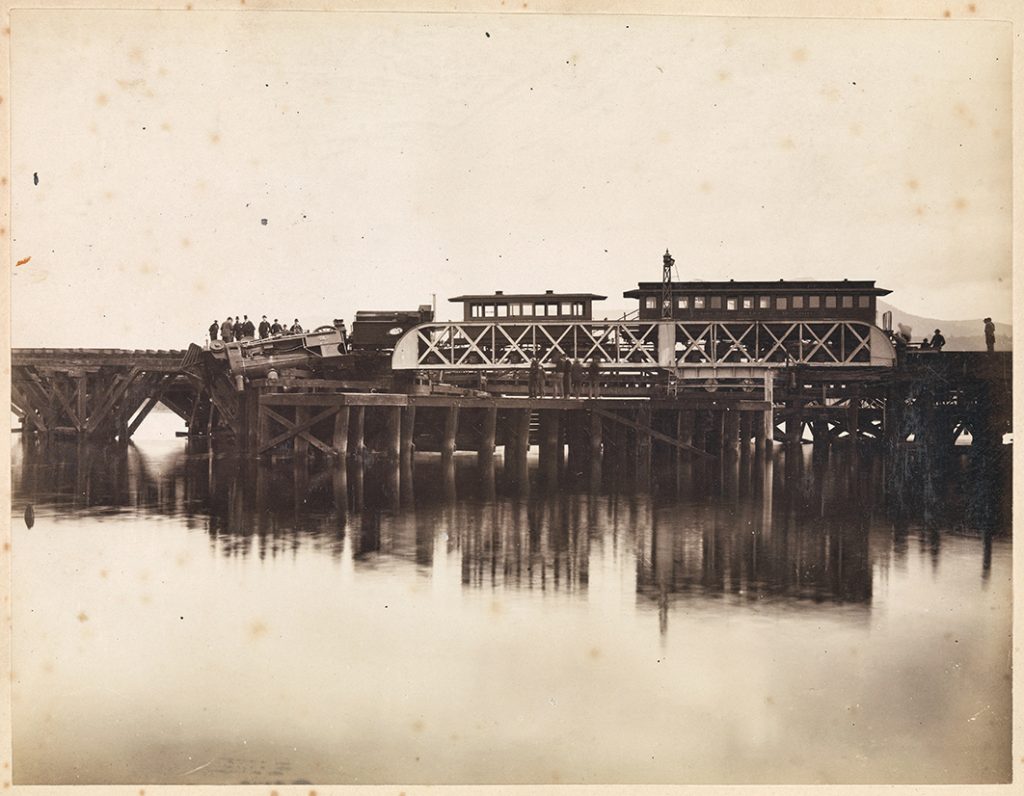
Derailed train at Bridgewater Bridge, 1886 (Tasmanian Archives: PH23/1/33)
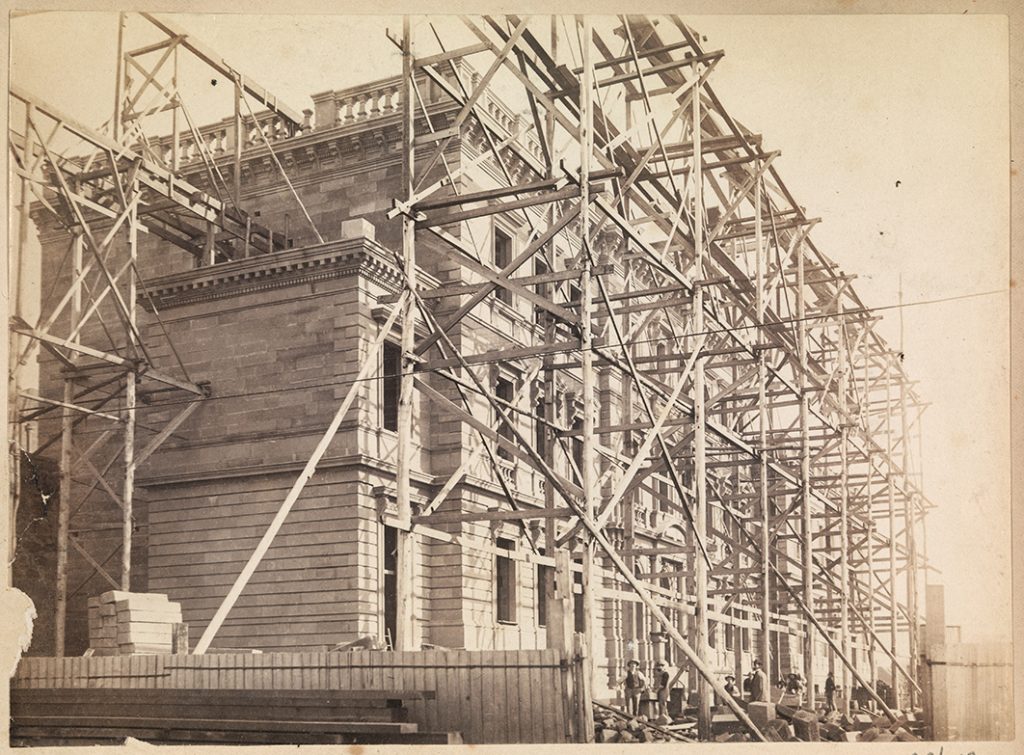
Photograph – Government Executive Council offices – construction works between 1884 and 1888 (facing Franklin Square) (Tasmanian Archives: PH23/1/43)
Beaconsfield Mine photographs c1900s (Tasmanian Archives, NS961)
These photographs have been collected by the West Tamar Historical Committee. Images include the Beaconsfield area, the mine, and people. While the images are now in the permanent custody of the Tasmanian Archives, when they first came to the Archives it was only as a loan so that reference copies could be made. Low resolution reference copies can be found online within the general photographic series PH30. These photographs are on open access, however for any reproduction beyond research purposes please contact the Beaconsfield Mine and Heritage Centre. The collection came to the Archives via the former West Tamar Historical Committee (WTHS), which is managed through the Beaconsfield Mine and Heritage Centre. This Centre has given permission for the Archives to digitise the images so that they can be available to the community.

Beaconsfield Mine [Page 16, Nightingale Album NS961/1/1] (Tasmanian Archives: NS961/1/33)
![Miners, afternoon shift, 29th May 1908 [includes names]](/wp-content/uploads/2024/07/NS961-1-123-658x1024.jpg)
Miners, afternoon shift, 29th May 1908 [includes names] (loose item from NS961/1/3, ‘D’) (Tasmanian Archives: NS961-1-123)
Prince of Wales visit to Launceston (Tasmanian Archives, LPIC112/1/1-42)
This Collection includes a set of postcard photographs of the Prince of Wales visit to Launceston issued by the Weekly Courier in 1920. Also includes shots of Geard’s Bodyworks, Launceston; a road trip through the Weldborough Pass showing the gates of the property “Betterole”; and the start of the Briseis water race on “Lee Holme”, property of Mr Basil Nillson. These records are part of the Launceston Manuscript Collection.
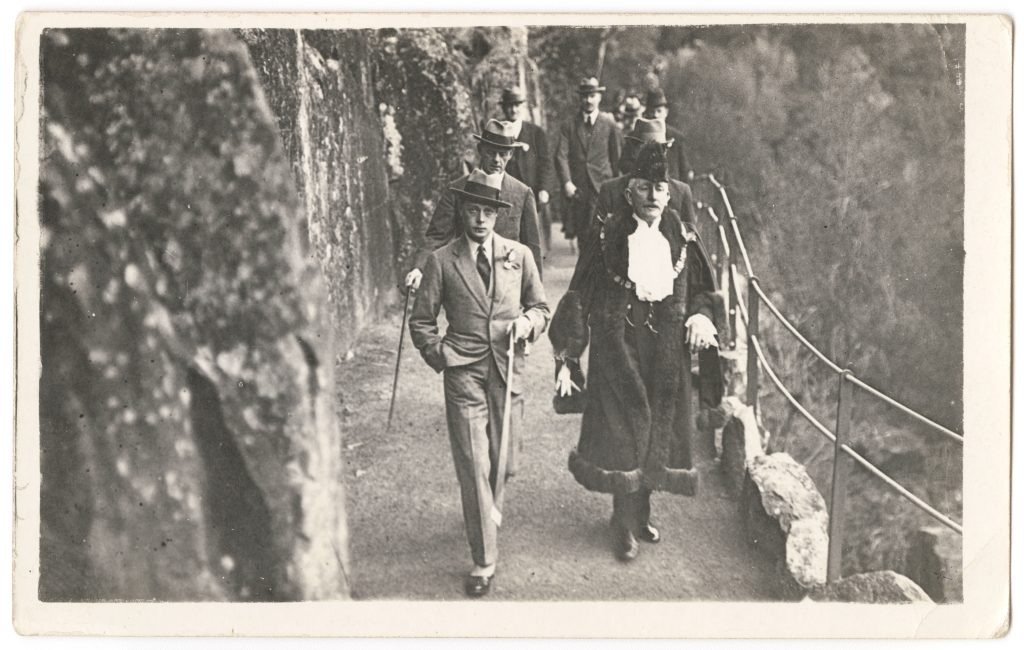
Edward, Prince of Wales with George Shields, Mayor of Launceston, and Admiral Halsey walking along the Cataract Gorge path / photographer Spurling Studios (Tasmanian Archives: LPIC112/1/6)
Bull Bluff by George McDougall (State Library of Tasmania Heritage Collections, Tasmaniana)
“The artist, George Frederick McDougall (c.1825-1871) served as master on the Resolute, and this picture would have been made in the spring sledging season of 1853. Resolute and Intrepid were the western division of Sir Edward Belcher’s ambitious Arctic Searching Squadron, and had overwintered off the coast of Melville Island at 75° North. Their sledging expeditions saw them attempt not just to locate the lost ships and men of Sir John Franklin, but also those of Enterprise and Investigator – two previous search parties with whom the Admiralty had lost contact. Whilst, unbeknownst to them, the Enterprise had made its own way to safely out of the ice, a sledging party from Resolute, like those depicted in this watercolour, did manage to locate and rescue Captain McClure and the crew of the Investigator. They found no meaningful trace of the Erebus and Terror, but the surveying they conducted from these sledging expeditions did add considerably to the known geography of the Arctic region. Manhauling a sledge through the slushy thawing ice of an Arctic spring was, by all accounts, backbreaking work. Weighed down with provisions, the eight or ten man teams were harnessed into drag ropes, and pulled these unwieldy crafts over incredibly difficult terrain. In the right wind the assistance of a sail, as here pictured, would have offered a welcome push. The scouts, walking alongside the sledges armed with rifles, were both on alert to protect the parties from bear attack, and to take any hunting opportunity that might provide fresh meat for the men. This watercolour comes from the private collection of Captain Kellett, and no doubt served as an aide memoire to his sledging experience. McDougall, in his expedition narrative, recalls of Kellett: “The Captain had, until this, been ignorant of the description of labour and exertion required for arctic travelling, which he candidly confessed surpassed everything in the form of hard work he had ever seen, though his experience in the navy embraces a period of upwards of twenty-five years, during which time he has seen much arduous service in every clime.”
George Frederick McDougall, The Eventful Voyage of H. M. Discovery Ship “Resolute” to the Arctic Regions In Search of Sir John Franklin (London, 1854), p. 212.”–Auction catalogue.
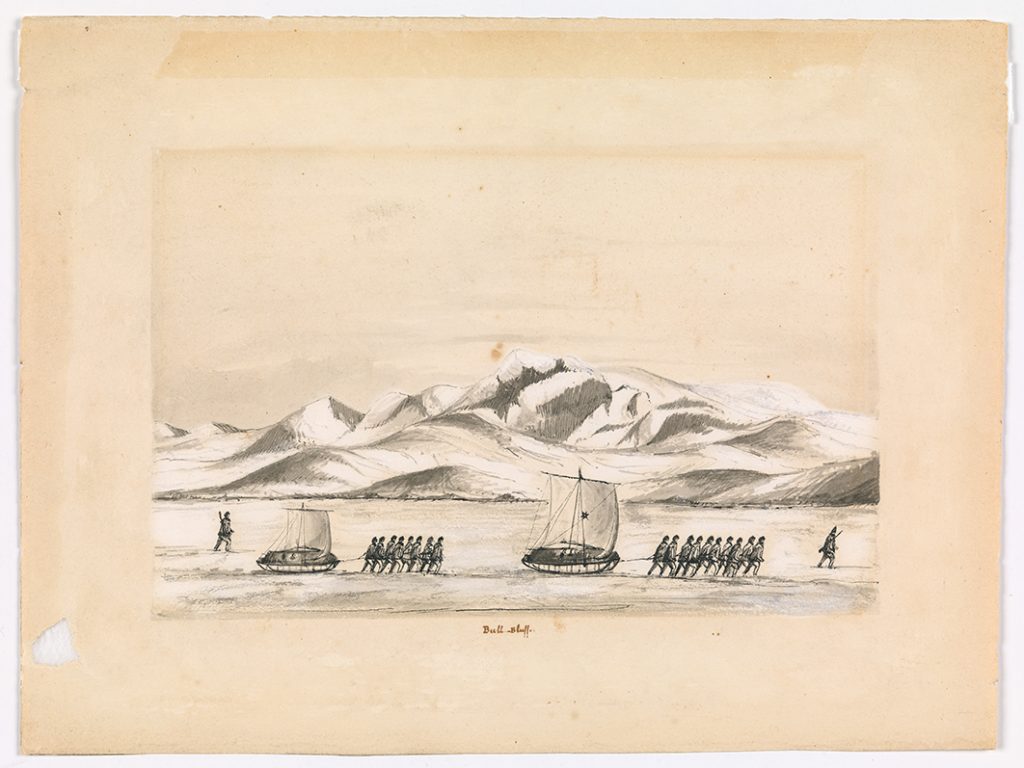
Pioneers of Jericho, c1930 (Tasmanian Archives, LMSS503-1-1)
This 60-page typed manuscript describes the history and pioneers of Jericho by Wilfred Hudspeth, son of Francis and Lucy Hudspeth (nee Cogle), who was a lawyer and amateur historian. He was a member of the Royal Society, a trustee of the Tasmanian Museum and participant in the cultural life of Tasmania. He researched and wrote extensively on various aspects of Tasmanian history.

Register of Applications for Certificates
The digitisation of these land records will assist researchers seeking to find out the history of a property.

Tasmanian Archives: LTO25/1/1, Register of Applications for Certificates of Title 1862-1973 (No.1 – 5506)
Tasmanian Archives: LTO30/1/1, Register of Applications for Grants of Land 1863-1960 (No.1 – 1460)
Tasmanian Archives: LTO31/1/1, Register of Applications to be registered as a proprietor 1864-1969 (No.1 to 5658)
Tasmanian Archives: LTO31/1/2, Register of Applications to be registered as a proprietor 1864-1969 (No. 5659 – 12034)
Sketches in Van Diemen’s Land, 1834 (State Library of Tasmania Heritage Collections, Tasmaniana).
This miniature book was created by John Callaghan and kindly donated by the family of Clare Christopher Cormac Lowther formerly of Coburg, Victoria. It describes Tasmanian life in the 1830s and contains with 2 ink drawings of Tasmanian Aboriginal people, accompanied by a small folded lithographic print of a Tasmanian Aboriginal man, which appears to have been cut from the title page of a copy of ‘Van Diemen’s Land almanack for the year 1833’.
“This small treatise was never intended to come before the public, and should it fall into the hand of the critic, it is hoped its errors as a manuscript will be overlooked, as its content is not of serious importance to posterity. It was compiled solely for the purpose of passing away the tedious hours, when alone, unemployed. J.Cn. Launceston July 1st, 1834”
-John Callaghan, To the Reader, page 1.
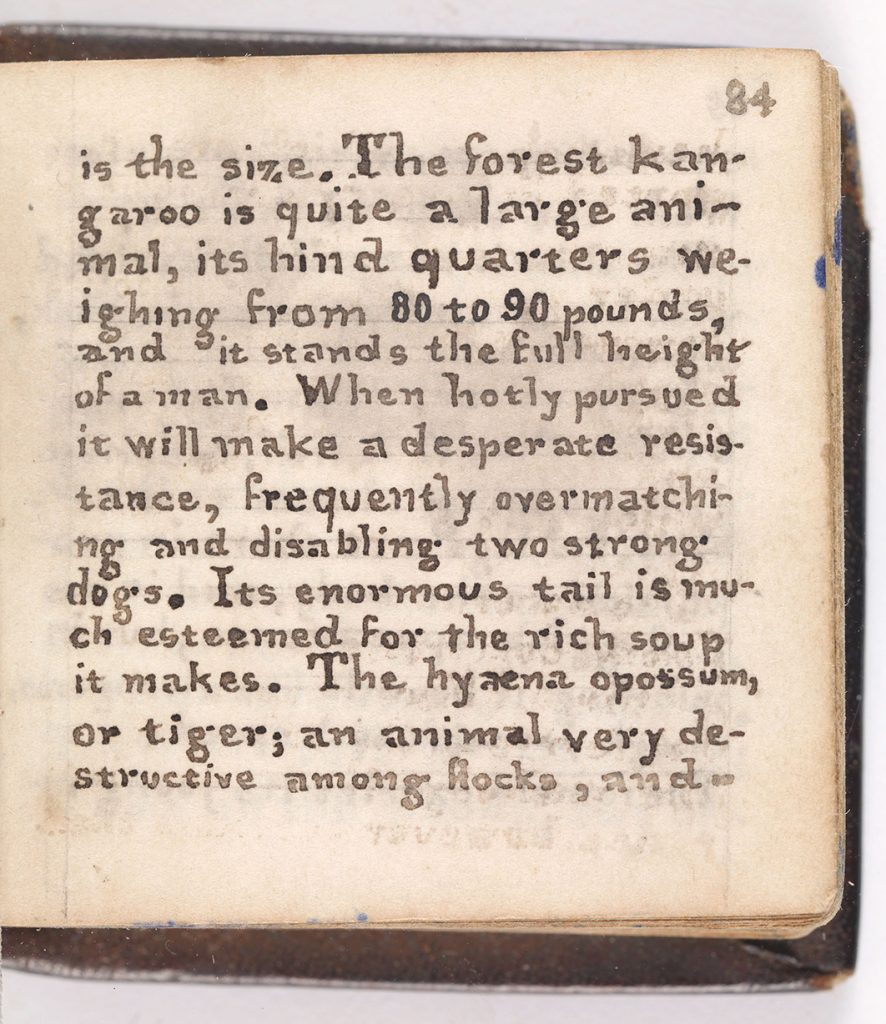
The feminin’ monarchi’, or, The histori of bee’s (State Library of Tasmania Heritage collections, Tasmaniana)
Regarded as the first substantial work on the science of beekeeping in the English language, by English naturalist and apiarist Charles Butler (1560-1647). He not only describes contemporary methods of beekeeping, but also provides his own proposals for practical improvements. This item is included as part a donation of family records and letters from Thomas Lewis, Henry James Brock, James Tulloch, Smiths and their descendants.

Petition for Perth Bridge, 1835 (Tasmanian Archives: CS01-1-828-17584, Page 174)
The Perth Bridge was built a year after this petition although rebuilt after the 1880, 1929 and 1971 flooding. This petition is from the CSO1 series, which contains correspondence chiefly of the period of the first Lieutenant-Governor of Van Diemen’s Land after it became an independent colony, Col. George Arthur. Many of the papers also are from his predecessor, Col. William Sorell. and date from as early as 1821, sometimes earlier. To discover more about the history of the Perth Bridge, visit The Bridge | Perth Research Room (perthtas.com).
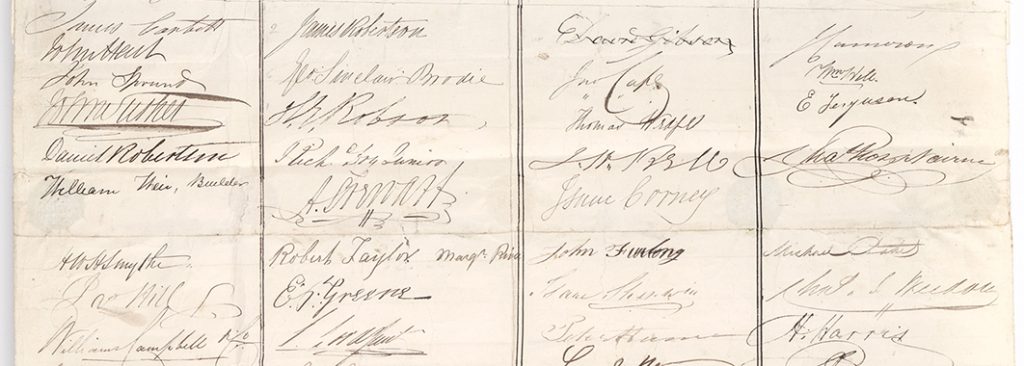
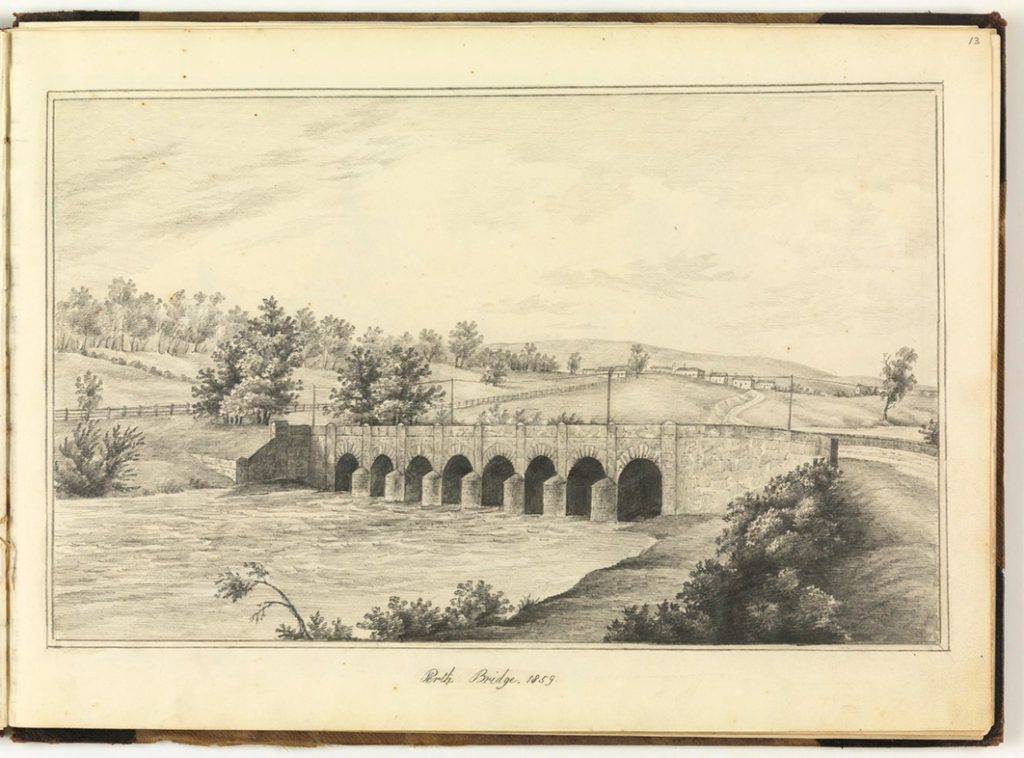
Perth Bridge, 1859 by Emily Bowring (State Library Heritage Collections, Allport Library and Museum of Fine Arts)
Films
Scenes of Hobart’s waterfront, city centre and outlying districts. Photographed by G.H. Bale.
A travel film with a poetic narration and orchestral soundtrack on Tasmania: ‘…set like a scenic tapestry in the Southern Ocean’. The film includes scenes of Hobart, Ross, Lake St Clair and bushwalking, the Hydro-Electric Commission (HEC), Mt Lyell and Queenstown, the Derwent Valley and the hatchery at Plenty, the Shannon Rise and Miena Dam. Produced by the Commonwealth Film Unit.
Covers various Tasmanian industries and companies. Includes footage of Hydro-electric power, Savage River, Hobart Street scenes, Ansett, Apple picking and packing, Cadbury’s Chocolate packing, Ovaltine production, North-Western Co-Operative Dairy Company, Peters Ice Cream Company, seaweed harvesting, Bridport trout farming, hardwood forests, Boyer pulp mill, Kelsall and Kemp, Paton’s and Baldwin’s, James Nelson, Silk and Textile Printers. Produced for the Directorate of Industrial Development and Trade Tasmania.
A silent black and white film, Hobart Cup shows views of the Hobart Racing Club (now known as Elwick Racecourse) on 22 January 1913. Scenes include the arrival of the Governer General, a brass band, mounted police, top hats, bets and the excitement of race day.
An American photographer on location in Tasmania meets a local girl who guides him around Hobart’s tourist places and spots to wine and dine. He goes back to New York determined to return. A Broadway musical style soundtrack features Mexican Beat by Jack Trombey and The International Studio Group. A TASFILM Production.
Explore 1920s Hobart and surrounding suburbs including Hobart Harbour, Town Hall, General Post Office, The University, Franklin Gardens, Mount Wellington, Brown’s River, Tourist steamers and The Salmon Ponds. Produced by Australasian Films Ltd, Sydney.
Explore 1960s Hobart and surrounds, including attractions and industries of the Huon Valley – power boating, trout fishing, timber cutting, the Hartz Mountains National Park, bush walking, Hastings limestone caves and the apple and hops industries. Produced by The Department of Film Production, Tasmania.
Apple farms and hop fields in the Huon, Lenah and Derwent Valleys. Includes the river steamers used to transport the produce to Hobart for export. Orchardists of the future take their first lessons in packaging.
An examination of the complex process of apple export. Handling apples is a skill and requires proper picking, careful grading, care in sorting, sizing and packing. See how the skilled apple grader and packer ensures the best quality fruit reaches the marketplace.
A canoe trip along the River Derwent begins at the source in the Highlands at Lake St Clair/Cradle Mountain National Park. The canoe passes by Butler’s Gorge, the HEC projects, Meadowbank, Bushy Park, Gretna, forests and hop fields, New Norfolk and ends where the river meets the sea in Hobart. A Tas Film Production, Tasmanian Film Corporation 1965.
Go back to 1939 to experience a two-day hiking trip in the Tasmanian Wilderness. A Tasmanian Government Tourist Department production.
Walk the streets of Hobart, 1961. Footage includes the Government Tourist building, State Library mid-construction, Tatler, Richardsons, Hobart Saving’s Bank, Myer, Paterson’s Home furnishings, Cat & Fiddle sign, Collin’s Court, TAA building, Carlton Hotel, Bank Arcade and Edments. Footage taken by Oscar Allen Wilson.
A poetic narrator guides the viewer through the wilderness of western Tasmania and the Cradle Mountain Reserve. See the way the walkers of yesteryear climb the mountain peaks and cross the wild rivers. Produced by the Dept of Film Production Tasmania. Photographed by Don Anderson.
Spring is the final film in a series of four. The joy of spring is explored through visits to many iconic Tasmanian locations and events. Visit a retro Salamanca Market, Royal Hobart Show and Regatta Day. Directed by Don Anderson A Tasmanian State Film Unit Production in association with Leo Burnett Pty. Ltd. for the Tasmanian Government Tourist Bureau.
The 1977 Summer School as seen from a cellist’s viewpoint. Sit in on a session at Claudio Alcorso’s home, Moorilla Estate, 34 years before MONA opened. Made with the assistance of the Tasmanian Conservatorium of Music. Narrated by Sue Pickering.
Glimpses of life in the pioneering days of Tasmania. Featuring the historic village of Richmond with important architecture dating back to the 1830s. Although no people are seen, their voices echo through the empty streets and buildings. A Tasmanian Film Production.
A note about permissions
We love it when people use our resources. If you’d like to use our images or films in your book, manuscript, documentary, blog, or social media, please do make sure that you ask permission first. You can find out how to do this on our Writers and Publishers page (which has a link to the permission form).
Please feel free to ring us for advice or help. You can find our telephone numbers on our Help Desk.


Hi, Thanks for all the wonderful work you do at Archives. I will giving as talk at Oatlands tomorrow and will mention on your new additions.
Best wishes
I am very interested in the work of James Sprent and would like to see his log books available on line.
Thank you for your suggestion Robert, we will add them to the register of suggestions for digitisation.